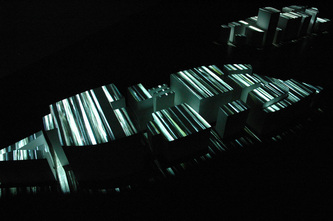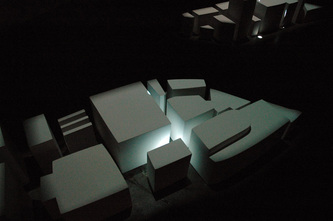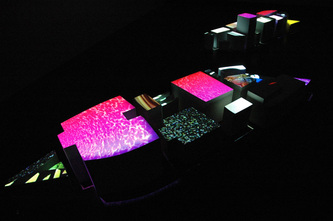Floating Plaster/City Motion, 2006 (collaboration with Yuki Nakamura)
cast Hydrocal, 3-channel synchronized projection, audio
dimensions variable
Henry Art Gallery, Seattle, WA
El Museo Cultural, Santa Fe, NM
911 Media Arts, Seattle, WA
VIDEO
cast Hydrocal, 3-channel synchronized projection, audio
dimensions variable
Henry Art Gallery, Seattle, WA
El Museo Cultural, Santa Fe, NM
911 Media Arts, Seattle, WA
VIDEO
Kingdom, Come
The Closed-Circuit City at 911 Media Arts
by Jen Graves
In the perpetual future, our size is changeable. While we become godlike, peering down at a small earth from planes and spaceships and skyscraper observatories, through microscopes and zoom lenses, we burrow like ticks. The artists Yuki Nakamura and Robert Campbell transport us back now to a quaint mutation of scale—the miniature movie set—but instead of blowing up the sculptural miniature into a photographic cinema that reinforces natural scale, they construct a defiant, desirable city where no person can live, a city that goes on despite us. It is forever small, and we are forever too big. Now we are like gods who wish to be human again.
The installation, called Floating Plaster/City Motion, sits on the floor in a dark room at 911 Media Arts Center. It is two silent white islands, which also resemble glowing ships of empire, of cast-plaster shapes with urban-style canyons between. The islands are based on the footprints of the Ile Saint-Louis and the Ile de la Cité in Paris, but they have become anonymous. Three synchronized projectors create one moving image across the surfaces of the buildings and streets and alleys. Bits of snow drop on the two cities, streaks of traffic careen down their avenues, and the cities are caressed by sun, sketched by architects, and destroyed by bombs. The animated realm that results from the changing combination of surface and form is abstract and suggestive, like a map, a telescoped view, a war zone broadcast from a safe distance.
This piece—one of the most ravishing new works I've seen in several months—is part of 911 Media Arts Center's "New Works Laboratory," which pairs traditional-media and new-media artists.
The Closed-Circuit City at 911 Media Arts
by Jen Graves
In the perpetual future, our size is changeable. While we become godlike, peering down at a small earth from planes and spaceships and skyscraper observatories, through microscopes and zoom lenses, we burrow like ticks. The artists Yuki Nakamura and Robert Campbell transport us back now to a quaint mutation of scale—the miniature movie set—but instead of blowing up the sculptural miniature into a photographic cinema that reinforces natural scale, they construct a defiant, desirable city where no person can live, a city that goes on despite us. It is forever small, and we are forever too big. Now we are like gods who wish to be human again.
The installation, called Floating Plaster/City Motion, sits on the floor in a dark room at 911 Media Arts Center. It is two silent white islands, which also resemble glowing ships of empire, of cast-plaster shapes with urban-style canyons between. The islands are based on the footprints of the Ile Saint-Louis and the Ile de la Cité in Paris, but they have become anonymous. Three synchronized projectors create one moving image across the surfaces of the buildings and streets and alleys. Bits of snow drop on the two cities, streaks of traffic careen down their avenues, and the cities are caressed by sun, sketched by architects, and destroyed by bombs. The animated realm that results from the changing combination of surface and form is abstract and suggestive, like a map, a telescoped view, a war zone broadcast from a safe distance.
This piece—one of the most ravishing new works I've seen in several months—is part of 911 Media Arts Center's "New Works Laboratory," which pairs traditional-media and new-media artists.








